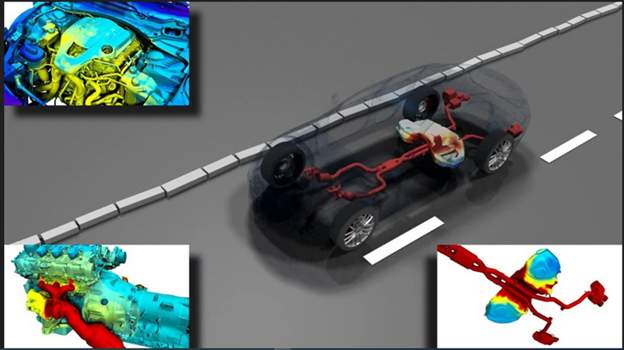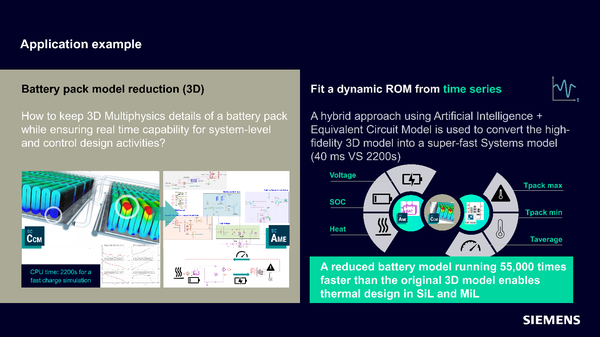AI Speeds Design Simulation
Using artificial intelligence and machine learning, the time to set up workflows and run simulations is reduced.
March 27, 2023

Justin Hodges, AI/ML technical specialist at Siemens Digital Industries Software
In the modern age of increasingly complex products, the need for comprehensive simulations is vital to the development process but also increasingly difficult and time-consuming. Using artificial intelligence (AI) and machine learning (ML), the time required to set up workflows and run these complex simulations can be greatly reduced. Advanced AI-integrated tools, such as those found in Simcenter, part of the Siemens Xcelerator business platform of software, hardware, and services, can support orders of magnitude reduction in simulation project time, reducing down to hours that once took days or weeks.

By leveraging the power of AI to speed up the simulation process, valuable time is freed up in the development cycle – enabling wider design space exploration, shorter development cycles, and/or more rigorous testing. As the demand for smarter products delivered on shorter schedules continues to grow, AI will become an important tool supporting the invention of these cutting-edge technologies.
Challenges of Modern Simulation
Many modern products have grown to a level of complexity, both in the number of components and individual component designs, that validating designs manually has become nearly impossible. Over the years, designers have come to rely on computer-driven simulations, but these often take so long to prepare and execute that only a limited number can be run and still get the product to market on schedule. This leaves little time for additional design space exploration while burdening designers with the highly manual and repetitive tasks of preparing models for simulation, further slowing down the design process. Even once the best designs are selected, thousands of additional simulations need to be run to ensure safe operation under the wide variety of operating conditions they might experience during their lifetime.
Take, for example, the design of a car. To prepare the digital model for simulation, everything down to the nuts, bolts, and screws must be manually tagged so appropriate materials and levels of detail can be assigned to each component with specific operations needed for each. A highly manual and time-consuming process for hundreds or thousands of individual parts. Likewise, running something like an aerodynamic simulation at the high required fidelity takes a great deal of data center compute time as well, limiting the opportunity for testing alternative designs or leveraging detailed simulations in other stages of design.
The Power of AI-Driven Automation
AI and automation have always been well suited to each other and now, thanks to recent advances, AI is capable of taking on some of the more labor-intensive tasks of simulation as well, creating convenient automated workflows. With large neural networks able to accurately recognize hundreds or thousands of parts at a time, the once highly manual process of part classification can now be handled automatically. In the previous example of a car model, the traditional classification process could take an experienced engineer upwards of a week to complete manually. Whereas an AI model can be trained to complete it in just a few hours.

Besides the time savings, relying on AI to automate these repetitive, highly manual tasks minimizes inadvertent errors with the computer able to accurately and consistently classify all parts within a set margin of error. By contrast, a human often becomes more error-prone throughout labeling many thousands of parts compared to the relatively simple task of checking the work completed by the computer.
Allowing AI to take over menial tasks also frees up valuable time for designers to spend on the more important, higher-level tasks. AI offers a whole host of benefits when it comes to supporting the design process, however only designers have the imagination required to truly create something new. As AI takes on the ever-growing list of simple, yet time-consuming tasks needed to support the design process, designers can focus on areas they are best suited.
Surrogate Models Provide a Speed Boost
Another area where AI is providing a significant benefit in design simulation is surrogate models (also referred to as Reduced Order Models, or ROMs). Running high-fidelity simulations is both time-consuming and costly, meaning it is often reserved for only the most critical steps of the design process. While this is a natural product of the limitations of traditional simulation methods, it does mean that any simulations outside those critical areas are forced to use low-fidelity substitutes or simple approximations instead. However, by leveraging ML-driven surrogate models it becomes possible to gain the benefits of accurate and detailed high-fidelity simulation with the speed of a 1-D approximation.

ML-powered surrogate models are trained using the vast quantities of data generated by traditional high-fidelity simulations – extracting additional value from this expensive process beyond the simulation results in themselves. Once trained, these surrogate models can infer results in real-time, allowing designers to reap the benefits of high-fidelity simulation without the associated computing and scheduled costs. Surrogate models are even capable of inferring results beyond the scope of their training data, allowing them to provide basic validation for new and untested designs.
Once a surrogate model is trained and integrated into the design process, it can effectively reduce the time to run simulations in its area of training to near zero, freeing up valuable time for other aspects of the design process. Everything from more rigorous safety testing to a shorter design cycle, to explore a wider design space, is possible simply by having more time available to do it.
While the return on investment in the creation and usage of surrogates in speeding up the simulation process is clear, they can also assist in simplifying multi-software toolchains. These toolchains can often grow to become inconvenient and unintuitive as many different tools must be orchestrated to work together, either in parallel or series while staying in lockstep, since simulation results generated in one tool are needed to complete tasks in another. Surrogate models can help eliminate this by directly providing inferences and predictions based on the results of one tool within the framework of another. This way, a variety of physics can be included in design evaluations without complicated and tedious workflows involving many different tools and software.
Greater Fidelity System Simulations
The use of surrogate models is not limited to replacing high-fidelity simulations, they can also be used in areas where a high-fidelity simulation would be desirable but has traditionally been impractical. For example, take the simulation of a car using system simulation software such as Siemens Amesim, which combines results from many different disciplines to create a complete system model. Due to the limitations of modern hardware, this type of system can't simulate every element of the car in full detail. Instead, the results from various simulations on different components, such as the aerodynamics of the body or characteristics of the engine, are fed into the model as static, 1-D approximations.

Replacing these 1-D approximations for certain components in the system model with surrogate models, however, allows effectively full-detail simulations of every component to be present in the same model at the same time. This can be further extended to allow a greater flow of information between disciplines, such as a team designing an engine having full access to examine the impact of the aerodynamics from different body designs on engine efficiency.
Most product design today is highly predicated on prior generations of design, with this year’s smartphone or car bearing many similarities to previous years' designs. This allows existing surrogate models to be reused during future design cycles or serve as a starting point to quickly refine the model for the current product being designed.
Having access to reasonably accurate models of critical components from the very beginning of the design process offers many benefits. It enables designers to explore more alternatives earlier in the design cycle thanks to early validation of design concepts. This compounding effect helps improve the speed and value of surrogates over the years as they grow increasingly refined with each product generation.
AI Is Changing the Nature of Simulation
Simulation is a vital part of the design process which takes a larger role every year as products grow increasingly complex. Although simulation has proven to be a cost-effective way to validate and test designs, traditional computer-driven models can have trouble keeping pace as designs become more complex. With recent advances in AI and ML, simulation times can be cut down to minutes from days or even weeks with complexity and detail previously thought impossible at the tip of every designer’s finger. This in turn is redefining the way simulation is used in the design process, changing not just simulation, but the design process as a whole, to enable the creation of smarter, more innovative products with greater speed and efficiency than ever before.
Dr. Justin Hodges is an AI/ML technical specialist in product management at Siemens Digital Industries Software. He has multiple degrees including a Ph.D. in mechanical engineering from the University of Central Florida. Dr. Hodges' master's and doctoral research focused on film cooling flow fields, predicting turbulence and thermal fields using advanced turbulence modeling and machine learning approaches. At Siemens, Dr. Hodges is striving to augment the capabilities of engineering simulation using machine learning.
You May Also Like
.jpg?width=300&auto=webp&quality=80&disable=upscale)


